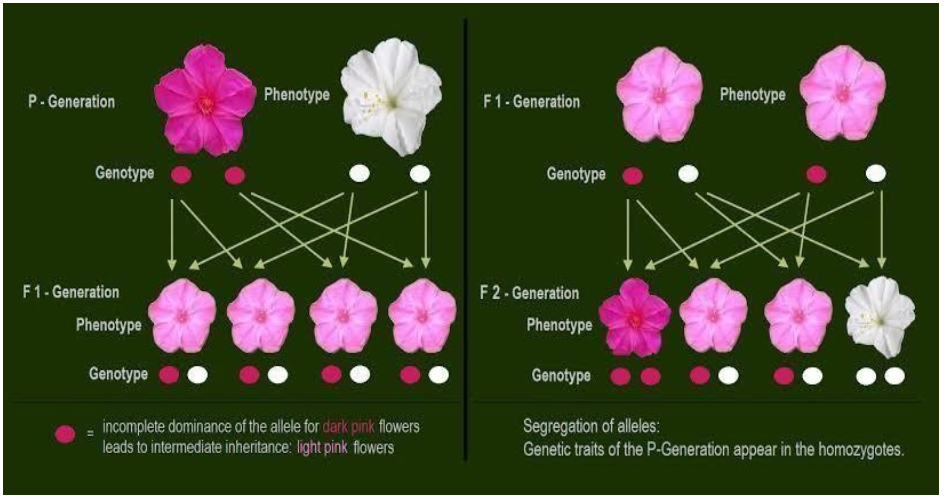
Incomplete dominance was discovered by
A. Correns
B. Mendel
C. Johannsen
D. Bateson
Answer
558.6k+ views
Hint: Incomplete dominance is a form of gene interaction in which both alleles of a gene at locus are partially expressed and results in an intermediate or different phenotype (i.e physical properties of an organism). It is also known as partial dominance.
Complete answer:
Incomplete dominance occurs because neither of the two alleles is completely dominant over the other. This results in a phenotype that is a combination of both.
Example : Monohybrid cross was done between the red and white colored flowers of snapdragon plant.Here, pure breed of red flower has RR pairs of alleles and that for white flowers it have rr pairs.
True breeding red (RR) and white(rr) flowers are crossed. The $\mathop F\nolimits_1 $ generation produced pink coloured flowers with Rr pairs of alleles.
Then $\mathop F\nolimits_1 $ generation was self pollinated. The results were red (RR), pink(Rr) and white (rr) in ratio 1:2:1.
In $\mathop F\nolimits_2 $ generation, the ratio was the same 1:2:1 . The phenotypic ratio changed from 3:1 to 1:2:1.
Incomplete dominance results in the blending of colours in flowers.
Example: In roses, the alleles of red colour is dominant over the allele for white colour.

Mendel was the founder of modern genetics and he gave the laws of Mendelian inheritance. Therefore, this option is not right.
Johannsen gave the explanation of genotype and phenotype of alleles. So, this option is not correct.
Bateson founded and named the science of genetics and his experiments provided evidence to modern understanding of heredity. Hence, this option is incorrect.
Correns is known for his independent discovery of the principles of heredity and also discovered non-Mendelian inheritance. So, this option is correct.
Note:
Allele is the alternative form of gene occupying the same position on the matching chromosomes. Incomplete dominance is when the dominant allele does not completely mask the effects of recessive allele , hence there occurs blending of both colors of alleles in flowers.
Complete answer:
Incomplete dominance occurs because neither of the two alleles is completely dominant over the other. This results in a phenotype that is a combination of both.
Example : Monohybrid cross was done between the red and white colored flowers of snapdragon plant.Here, pure breed of red flower has RR pairs of alleles and that for white flowers it have rr pairs.
True breeding red (RR) and white(rr) flowers are crossed. The $\mathop F\nolimits_1 $ generation produced pink coloured flowers with Rr pairs of alleles.
Then $\mathop F\nolimits_1 $ generation was self pollinated. The results were red (RR), pink(Rr) and white (rr) in ratio 1:2:1.
In $\mathop F\nolimits_2 $ generation, the ratio was the same 1:2:1 . The phenotypic ratio changed from 3:1 to 1:2:1.
Incomplete dominance results in the blending of colours in flowers.
Example: In roses, the alleles of red colour is dominant over the allele for white colour.

Mendel was the founder of modern genetics and he gave the laws of Mendelian inheritance. Therefore, this option is not right.
Johannsen gave the explanation of genotype and phenotype of alleles. So, this option is not correct.
Bateson founded and named the science of genetics and his experiments provided evidence to modern understanding of heredity. Hence, this option is incorrect.
Correns is known for his independent discovery of the principles of heredity and also discovered non-Mendelian inheritance. So, this option is correct.
Note:
Allele is the alternative form of gene occupying the same position on the matching chromosomes. Incomplete dominance is when the dominant allele does not completely mask the effects of recessive allele , hence there occurs blending of both colors of alleles in flowers.
Recently Updated Pages
A man running at a speed 5 ms is viewed in the side class 12 physics CBSE

The number of solutions in x in 02pi for which sqrt class 12 maths CBSE

State and explain Hardy Weinbergs Principle class 12 biology CBSE

Write any two methods of preparation of phenol Give class 12 chemistry CBSE

Which of the following statements is wrong a Amnion class 12 biology CBSE

Differentiate between action potential and resting class 12 biology CBSE

Trending doubts
What are the major means of transport Explain each class 12 social science CBSE

Which are the Top 10 Largest Countries of the World?

Draw a labelled sketch of the human eye class 12 physics CBSE

Explain sex determination in humans with line diag class 12 biology CBSE

Explain sex determination in humans with the help of class 12 biology CBSE

Differentiate between homogeneous and heterogeneous class 12 chemistry CBSE




